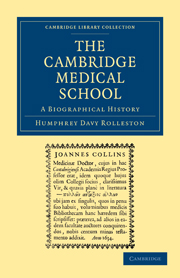Book contents
- Frontmatter
- Contents
- List of Plates
- Preface
- I The Medical School
- II Department of Anatomy
- III Department of Physiology
- IV Department of Biochemistry
- V Department of Experimental Psychology
- VI Department of Pathology
- VII Department of the Quick Chair of Biology
- VIII The Regius Chair of Physic
- IX John Caius
- X The Downing Chair of Medicine
- XI The Linacre Lectureship in Physic
- XII The Chair of Surgery
- Index of Persons
- Index of Subjects
- Plate section
I - The Medical School
Published online by Cambridge University Press: 07 September 2010
- Frontmatter
- Contents
- List of Plates
- Preface
- I The Medical School
- II Department of Anatomy
- III Department of Physiology
- IV Department of Biochemistry
- V Department of Experimental Psychology
- VI Department of Pathology
- VII Department of the Quick Chair of Biology
- VIII The Regius Chair of Physic
- IX John Caius
- X The Downing Chair of Medicine
- XI The Linacre Lectureship in Physic
- XII The Chair of Surgery
- Index of Persons
- Index of Subjects
- Plate section
Summary
THE history of the Medical School presents two distinct phases—a long period of somnolence, like that of the new-born infant, followed in the nineteenth century and after by the stage of progressive growth and activity. From the earliest days of the University until the last quarter of the nineteenth century the number of medical students in residence was small, and until the early nineteenth century those responsible for the Faculty of Medicine, which had existed from the first, were much inclined to treat their posts as sinecures.
As far back as the end of the twelfth century Cambridge was probably a place of study where schools of “glomery” or grammar existed. But “the earliest authentic instrument” containing any recognition of Cambridge as a University is a writ of the second year (February 17, 1217–18) of Henry III, a century before it received formal recognition as a Studium generale respectu regni or Universitas by a Bull from Pope John XXII in 1318. The Collegiate system was inaugurated in 1284 by Hugh de Balsham (obiit 1286), tenth Bishop of Ely, who founded Peterhouse (Domus Scholarium Sancti Petri) twenty years after Merton College, Oxford, was established by Walter de Merton (obiit 1277), Lord Chancellor.
The statutes of the University, like those of Oxford, were closely modelled on those of Paris which was a “Master-University”, or Corporation of Masters or teachers, in contradistinction to the “Student-Universities”, such as Bologna and Padua, in which the students' guilds largely chose and controlled the teachers.
- Type
- Chapter
- Information
- The Cambridge Medical SchoolA Biographical History, pp. 1 - 46Publisher: Cambridge University PressPrint publication year: 2009First published in: 1932

